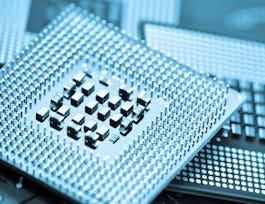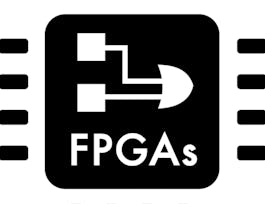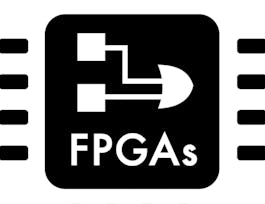This course is for anyone passionate in learning how a hardware component can be adapted at runtime to better respond to users/environment needs. This adaptation can be provided by the designers, or it can be an embedded characteristic of the system itself. These runtime adaptable systems will be implemented by using FPGA technologies.


FPGA computing systems: Background knowledge and introductory materials
Taught in English
Some content may not be translated
15,502 already enrolled
(233 reviews)
What you'll learn
How a hardware component can be adapted at runtime to better respond to users/environment needs using FPGAs
Details to know

Add to your LinkedIn profile
19 quizzes
See how employees at top companies are mastering in-demand skills


Earn a career certificate
Add this credential to your LinkedIn profile, resume, or CV
Share it on social media and in your performance review

There are 8 modules in this course
Nowadays the complexity of computing systems is skyrocketing. Programmers have to deal with extremely powerful computing systems that take time and considerable skills to be instructed to perform at their best. It is clear that it is not feasible to rely on human intervention to tune a system: conditions change frequently, rapidly, and unpredictably. It would be desirable to have the system automatically adapt to the mutating environment. This module analyzes the stated problem, embraces a radically new approach, and it introduces how software and hardware systems ca ben adjusted during execution. By doing this, we are going to introduce the Field Programmable Gate Arrays (FPGA) technologies and how they can be (re)configured.
What's included
7 videos5 readings5 quizzes
Traditionally, computing was classified into General-Purpose Computing performed by a General-Purpose Processor (GPP) and Application-Specific Computing performed by an Application-Specific Integrated Circuit (ASIC). As a trade-off between the two extreme characteristics of GPP and ASIC, reconfigurable computing has combined the advantages of both. On one hand reconfigurable computing can have better performance with respect to a software implementation but paying this in terms of time to implement. On the other hand a reconfigurable device can be used to design a system without requiring the same design time and complexity compared to a full custom solution but being beaten in terms of performance. The main advantage of a reconfigurable system is its high flexibility, while its main disadvantage is the lack of a standard computing model. In this module we are presenting a first definition of reconfigurable computing, describing the rationale behind it and introducing how this field has been influenced by the introduction of the FPGAs.
What's included
5 videos4 readings2 quizzes
From the mid-1980s, reconfigurable computing has become a popular field due to the FPGA technology progress. An FPGA is a semiconductor device containing programmable logic components and programmable interconnects but no instruction fetch at run time, that is, FPGAs do not have a program counter. In most FPGAs, the logic components can be programmed to duplicate the functionality of basic logic gates or functional Intellectual Properties (IPs). FPGAs also include memory elements composed of simple flip-flops or more complex blocks of memories. Hence, FPGA has made possible the dynamic execution and configuration of both hardware and software on a single chip. This module provides a detailed description of FPGA technologies starting from a general description down to the discussion on the low-level configuration details of these devices, to the bitstream composition and the description of the configuration registers.
What's included
8 videos3 readings2 quizzes
FPGA design tools must provide a design environment based on digital design concepts and components (gates, flip-flops, MUXs, etc.). They must hide the complexities of placement, routing and bitstream generation from the user. This module is not going through these steps in details, an entire course will be needed just for this, but it is important at least to have an idea of what it is happening behind the scene to better understand the complexity of the processes carried out by the tools you are going to use. Within this context, this module guides you through a simple example, which is abstracting the complexity of the underlying FPGA, starting from the description of the circuit you may be willing to implement to the bitstream used to configure the FPGA.
What's included
6 videos2 quizzes
Before continuing in this terrific journey in the reconfigurable computing area, it can be useful to define a common language. Obviously, some of these terms have been already used but it is now time to better understand them and to make some order before continuing with more advanced concepts. Furthermore, as we know, FPGA configuration capabilities allow a great flexibility in hardware design and, as a consequence, they make it possible to create a vast number of different reconfigurable systems. These can vary from systems composed of custom boards with FPGAs, often connected to a standard PC or workstation, to standalone systems including reconfigurable logic and General Purpose Processors, to System-on-Chip's, completely implemented within a single FPGA mounted on a board, with only few physical components for I/O interfacing. There are different models of reconfiguration, and a scheme to classify them is presented in this module. We can consider this module as a transitional/turning point module. We have been exposed to some terminology and concepts and we are now ready to move forward. To do this, we need to combine all the pieces of the puzzles together and to invest a bit at looking at the overall picture, and this is exactly what this module has been designed for.
What's included
5 videos2 readings2 quizzes
The reconfiguration capabilities of FPGAs give the designers extended flexibility in terms of hardware maintainability. FPGAs can change the hardware functionalities mapped on them by taking the application offline, downloading a new configuration on the FPGA (and possibly new software for the processor, if any) and rebooting the system. Reconfiguration in this case is a process independent of the execution of the application. A different approach is the one that considers reconfiguration of the FPGA as part of the application itself, giving it the capability of adapting the hardware configured on the chip resources according to the needs of a particular situation during the execution time. In this case we are referring to this reconfiguration as dynamic reconfiguration and the reconfiguration process is seen as part of the application execution, and not as a stage prior to it. This module illustrates a particular technique, which is extending the previous two, that has been viable for most recent FPGA devices, Partial Dynamic Reconfiguration. To fully understand what this technique is, the concepts of reconfigurable computing, static and dynamic reconfiguration, and the taxonomy of dynamic reconfiguration itself must be analyzed. In this way partial dynamic reconfiguration can be correctly placed in the set of system development techniques that it is possible to implement on a modern FPGA chip.
What's included
8 videos4 readings2 quizzes
After presenting different solutions proposed to design and implement dynamic reconfigurable systems, this module will describe a general and complete design methodology that can be followed as a guideline for designing reconfigurable computing systems. To design and implement a reconfigurable computing system, designers need Computer-Aided Design (CAD) tools for system design and implementation, such as a design analysis tool for architecture design, a synthesis tool for hardware construction, a simulator for hardware behavior simulation, and a placement and routing tool for circuit layout. We may build these tools ourselves or we can also use commercial tools and platforms for reconfigurable system design. The first choice implies a considerable investment in terms of both time and effort to build a specific and optimized solution for the given problem, while the second one allows the re-use of knowledge, cores, and software to reach a good solution to the same problem more rapidly. This module is guiding the students through an historical view on how CAD frameworks evolved through the years. This is done to show how fast the technology is evolving and the rationale behind the choice made to improve the users experience when working with an FPGA-based system. Not only commercial tools are described, but also the personal journey done by the course instructor and his research team, starting from his early days as a PhD up to the research challenges they are nowadays working on.
What's included
9 videos7 readings3 quizzes
We are working at the edge of the research in the area of reconfigurable computing. FPGA technologies are not used only as standalone solutions/platforms but are now included into cloud infrastructures. They are now used both to accelerate infrastructure/backend computations and exposed as-a-Service that can be used by anyone. Within this context we are facing the definition of new research opportunities and technologies improvements and the time cannot be better under this perspective. What it is needed now is new platform creation tools, monitoring and profiling infrastructure, better runtime management systems, static and dynamic workload partitioning, just to name a few possible areas of research. This module is concluding this course but posing interesting questions towards possible future research directions that may also point the students to other Coursera courses on FPGAs.
What's included
1 video3 readings1 quiz
Instructor

Offered by
Recommended if you're interested in Design and Product

Politecnico di Milano

University of Colorado Boulder

Politecnico di Milano

University of Colorado Boulder
Why people choose Coursera for their career




Learner reviews
Showing 3 of 233
233 reviews
- 5 stars
72.53%
- 4 stars
21.45%
- 3 stars
2.57%
- 2 stars
1.28%
- 1 star
2.14%
New to Design and Product? Start here.

Open new doors with Coursera Plus
Unlimited access to 7,000+ world-class courses, hands-on projects, and job-ready certificate programs - all included in your subscription
Advance your career with an online degree
Earn a degree from world-class universities - 100% online
Join over 3,400 global companies that choose Coursera for Business
Upskill your employees to excel in the digital economy
Frequently asked questions
Access to lectures and assignments depends on your type of enrollment. If you take a course in audit mode, you will be able to see most course materials for free. To access graded assignments and to earn a Certificate, you will need to purchase the Certificate experience, during or after your audit. If you don't see the audit option:
The course may not offer an audit option. You can try a Free Trial instead, or apply for Financial Aid.
The course may offer 'Full Course, No Certificate' instead. This option lets you see all course materials, submit required assessments, and get a final grade. This also means that you will not be able to purchase a Certificate experience.
When you enroll in the course, you get access to all of the courses in the Specialization, and you earn a certificate when you complete the work. Your electronic Certificate will be added to your Accomplishments page - from there, you can print your Certificate or add it to your LinkedIn profile. If you only want to read and view the course content, you can audit the course for free.
If you subscribed, you get a 7-day free trial during which you can cancel at no penalty. After that, we don’t give refunds, but you can cancel your subscription at any time. See our full refund policy.


